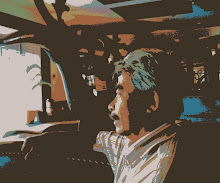

"Dewi Bunga" at SMK Bintulu (1975)
Recently I purchased the first day cover envelope and stamps marked 26.6.2007 from the Bintlu Post Office. The envelope had four different stamps costing 5o sen each with illustrations depicting four Malaysian traditional children's stories.
These gave me food for thought to jot down a couple of ponderings about school drama in Bintulu for the single reason that children's theatre should be produced more regularly in Bintulu. But are they? And in what form?
The Black Basin
My earliest experience in drama was in 1962 when I was a primary three school student at St. Anthony School, Bintulu., and which by the way is still standing proud today.
The drama was called " The Black Basin" and was an adaptation from Sun Juxian's play ( popular in China ) called " Story of the Black Basin" ( Wupen Ji). I was playing the role of a potter and selling hot millet soup on the busy streets of Kaifung. Everytime the central figure of the play appears on the streets, I would shout in my tiny and loud voice " Make way, make way for Bao Gong , the chief judge of Kaifung city". Way back then the small role that I took had tremendous impact on me because I began to admire plays or drama especially those in English and those acted by children. Of course as an added bonus my participation gave me courage to face audience and boosted my self-confidence early in life.
When I was in Form Three at SMK Bintulu (1965) I again took part in an English drama called " The Iron Man". The "iron man' is equivalent to what we create today called robots. The part of the iron man was taken by Mohidin Idris, now a pensioner in Bintulu in is late 50s.
In both plays that I acted, the concept of drama was adult drama to be played by children.
Dewi Bunga
But all these were to change. When I returned to my school as a trained teacher in 1975, I produced a play which I think was a truly children's theatre. It was called " Dewi Bunga". The drama was written in Bahasa Malaysia by Shamsiah Mohamad. In this play the children were playing the roles of children and interacting with characters from the animal and plant kingdom. I was excited to introduce to Bintulu a real children's theatre i.e. the experiences of life from the viewpoint of young eager, curious and happy minds. The child 's world of fantasy and unlimited possibilities and imagination were given a free rein. The animal and plant characters began to be alive with human values and freely interact with the children. The children could quickly and easily sympatise with the characters because these characters are close to the world of children every where in the world.
I spent a tremendous amont of my own money freely and happily to stage the drama.
Today when I look at the first day envelope, I realise how I enjoyed my primary and secondary schooling in Bintulu. I was an active team player ( in today's management terminology) in the production of English and Bahasa Malaysia drama . Whether the plays are in English or Bahasa Malaysia is of irrelevance. In producing dramas, we should write the script from the children's point of view or from the "eyes "of the children.
I looked at the brochure that accompanied the first day cover envelope and read the synopsis of the well-known Malaysian folk tales. I hought why don't the schools in Bintulu produce children's theatre based on these stories and staged them on any of the public stages so abundant in Bintulu today?
The folk tales written in the brochure are:
a) Sang Kancil and the Crocodles
b) Sang Kancil Helps Kerbau
c) Bawang Putih Bawang Merah
d) Badang ( a bit of an adult dama , I think)
e) Mat Jenin ( a bit of anadult drama,I think)
Reflecting back on the words that I shouted on the streets of Kaifung city in 1962, I realise now that like Bao Gong ( remember , the Chief Judge) people will somehow give way to the man with an agenda. A man of agenda is a visionary, an entrepreneur, and a man of vision.
Have we given enough of those to our children today?

No comments:
Post a Comment